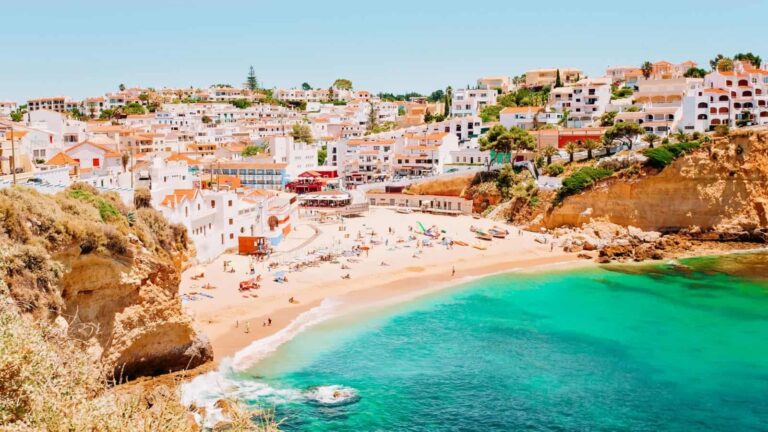If Portugal isn’t already on your bucket list, it should be. This sun-drenched slice of Europe packs in medieval towns, dramatic coastline, fresh seafood, soulful music, and jaw-dropping scenery at nearly every turn. But while it looks like a traveler’s dream on Instagram, visiting Portugal requires more than booking a flight to Lisbon and winging it from there.
I’ve put together the essential guide to help you plan a smooth and satisfying trip—packed with honest pros, the occasional pitfall, and smart tips that will help you enjoy every vinho-soaked minute.
Beyond the Big Three: Go Off-Track
Let’s get this out of the way: Lisbon, Porto, and the Algarve are lovely. But if you want to experience the real Portugal, don’t stop there. Towns like Braga and Guimarães in the north offer incredible architecture and historic charm with a fraction of the crowds. Coimbra has a gorgeous university and haunting fado music. Nature lovers? Peneda-Gerês National Park is raw, lush, and nearly tourist-free.
Getting Around: Trains, Tolls, and a Dose of Patience
Public transport is decent—especially between major cities. Trains and buses run fairly reliably and are inexpensive. But if you’re looking to explore beaches, hidden valleys, or remote villages, a rental car is your best bet. Just know what you’re getting into: toll roads are everywhere, and Portuguese drivers have a… spirited style.
Not ready to brave the highways? Uber is widely available and surprisingly affordable in cities.
Smart Travel Planning = Less Stress
Portugal’s shape makes it perfect for a one-way route. Try flying into Porto and out of Faro (or vice versa). That way, you’re not retracing your steps, and you’ll see a broader slice of the country. Bonus points if you use a budget airline like Ryanair or easyJet—they connect Portugal to dozens of European hubs at bargain prices.
Got a stopover on TAP Portugal? You may be able to score up to 10 free nights in Lisbon or Porto. But a word of caution: locals jokingly say TAP stands for “Take Another Plane” due to its infamous delays.
When to Go: Timing Is Everything
Avoid July and August if you can. This is when the crowds swell, the sun scorches, and prices skyrocket. May–June and September–October hit the sweet spot—pleasant weather, manageable lines, and fewer selfie sticks in your way.
Still, don’t expect complete solitude. Portugal is a favorite among European travelers year-round.
Where to Stay: Think Like a Local
Instead of just taking day trips to places like Sintra or Óbidos, book a night or two. Early mornings and late evenings are the only times you’ll get iconic spots (like Pena Palace) without elbowing your way through a sea of tourists. And prices for accommodation can actually be lower than in Lisbon’s city center.
If you’re into unique stays, consider somewhere like bolhas da montanha in central Portugal—far from the crowds and close to nature.
Language and Culture: Small Efforts Go Far
While English is spoken in Lisbon and Porto, smaller towns may be trickier. Learn basic Portuguese phrases like “Olá” (hello), “Bom Dia” (good morning), and “Obrigado/a” (thank you). Also—this is important—don’t assume people speak Spanish. They’ll likely understand you, but it’s not the same language and comes off a bit rude.
Want to go the extra mile? Learn European Portuguese, not Brazilian. The difference is significant.
Walking Shoes, Not Flip-Flops
Cities like Lisbon and Porto are beautiful but brutal on your legs. Hills are steep, sidewalks are slippery, and rain makes cobblestones treacherous. Comfortable, sturdy shoes are a must.
And yes, you’ll sweat, but bring a jacket anyway. The Atlantic breeze can chill you fast—even in summer.
Sightseeing: Choose Wisely
Some attractions are worth every cent. Others? Not so much. The Santa Justa Lift in Lisbon looks amazing—but skip the lines and walk up instead. Tram 28 is iconic, but packed and ripe with pickpockets. Lello Bookstore in Porto is stunning, but unless you’re in line at opening, expect a crowded, overpriced experience.
For better experiences, search for “Miradouros” (viewpoints). They’re everywhere and often come with the best photos and fewest tourists.
Eating and Drinking: Know Before You Sit
Portuguese food is hearty, fresh, and affordable—if you avoid the traps. Restaurants with photos on the menu or staff coaxing you inside are red flags. Walk a few blocks away from tourist sites for better meals at better prices.
Sample regional specialties: Bacalhau (salt cod) is cooked 365 ways. Porto’s Francesinha is a messy, meaty masterpiece. And Pastéis de Nata in Lisbon are divine little custard bombs.
Order Petiscos (small plates) to try a bit of everything without going broke.
Dining Etiquette 101
Dinner starts late—around 8 or 9 p.m.—and can go on for hours. Don’t expect quick service. Some places even close between 3–7 p.m., so plan snacks accordingly.
That bread and olives they bring to your table? It’s called Couvert and it’s not free. Refuse it if you don’t want to pay the 1–2 euro charge.
Tipping isn’t mandatory. Rounding up or leaving 10% is appreciated but not required.
Money Matters: Small Bills, Big Caution
Cash is still king in many places. Carry small denominations (under €10). Cafés and taxis often won’t break large bills. And speaking of money: Portugal, especially Lisbon, has its fair share of pickpockets. Only carry what you can afford to lose.
Lastly, avoid sketchy street vendors offering “sunglasses” that somehow turn into drug deals. They’re fake and not worth the risk.
Final Thoughts: Portugal Is Worth the Learning Curve
Portugal isn’t flawless—it has crowds, quirks, and the occasional scam. But for every frustration, there’s a clifftop view that silences it. Or a sip of Vinho Verde that makes it all okay. Or a quiet, cobbled street that feels like a secret, just for you.

